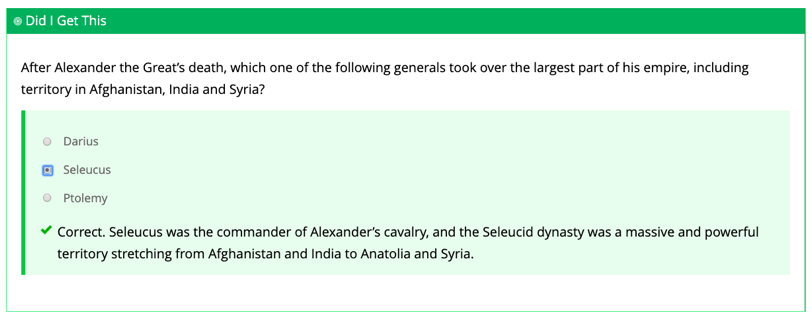Personalised and adaptive learning are not necessarily new terms, dating back to the 1960s and 1970s respectively, but even today there is no blanket definition for either, meaning the line drawn between the two can often be blurred. Whilst personalisation is primarily focused on responding to a student’s input and offering guidance around their learning behaviours, adaptivity offers each student a different assessment depending on their competencies.
In simple terms:
Adaptivity: Each student takes an adaptive test and receives more content on topics they do not perform as well on. This can be used to ensure students have the prerequisite knowledge needed to begin a new course.
Personalisation: Students receive personalised feedback and prompts to behaviours that will improve their outcomes, such as “I’ve noticed that when you get an answer wrong, you don’t check the other answer options. Students in this course who do tend to score as much as 12 points higher on the final exam.”
Acrobatiq® by VitalSource employs the methodology that both approaches should be used in tandem, to drive deeper learning. Whilst everyone has their own individual way of defining adaptivity, they believe that core content should remain just that, core content, with adaptive assessments being deployed alongside to give students the scaffolding they need when they need it. All students will receive the necessary, fundamental material along with adaptive content both during the course and before it starts. This adaptivity can be presented in several ways:
- Number of questions presented
- Topical area targeted
- Delivery of remediation lessons/assets
- Focus on underperforming competencies or sub-skills
- Additional scaffolding around low competence topics
But why is it time to start paying attention to these improved methods of teaching? In 2017, research undertaken at the Western Governors University’s (WGU) psychology programme used final exam data before and after Acrobatiq adoption to find the correlation between personalised learning and improved outcomes. The most notable improvement was that of students receiving the Pell Grant, a subsidy from the US Federal government that pays for students to attend college, largely assisting undergraduates from low-income families, similar to the Higher Education Participation and Partnerships Program (HEPP) in Australia. Before the Acrobatiq adoption, there was a 14 point difference of pass rate with these students and those not receiving the grant, but when using Acrobatiq this difference could hardly be seen, raising their final exam scores and effectively closing the gap experienced by Pell students. It is also important to remember that 50% of students in Australia are first generation, who are not covered by HEPP and that 26% of those from this demographic indicate they are likely to drop out in Year 1. The WGU research student profile heavily consisted of first generation students, with 46% of the 1,898 participants sitting within this demographic. There was an 8 point difference in percentage of the 1,204 who used Acrobatiq, and the remaining 694 who were in the control group. This statistic, alongside the indicators that the Pell gap is closed, go to show how important personalised and adaptive learning can be for under represented and first generation students when it comes to retention and outcomes.
In 2017, a report published by the Grattan Institute also found that 40% of students in Australian schools are disengaged from their learning. Cognitive and learning science research suggests that by moving towards a learner-centred, “active learning” instructional model, supported with technology that enables a more personalised learning experience, students are more likely to engage in the learning process and take more ownership for their learning success. Carnegie Mellon, the university that Acrobatiq was born out of, also investigated how different patterns of student use corresponded with different student learning outcomes. They found that “while more watching, reading and doing all predict better learning outcomes, the amount of learning associated with each activity done was six times greater than for each video watched or page read.” It’s hard to deny that personalised and adaptive learning could be just the tools needed to engage the students of Australia again.
If you think personalised or adaptive learning could be something that will benefit your students, find out more by reading our research brief.
VitalSource operates globally with offices in Raleigh, NC; Boston, MA; La Vergne, TN; London, UK; and Melbourne, Australia.
Do you have an idea for a story?Email [email protected]
 Campus Review The latest in higher education news
Campus Review The latest in higher education news


